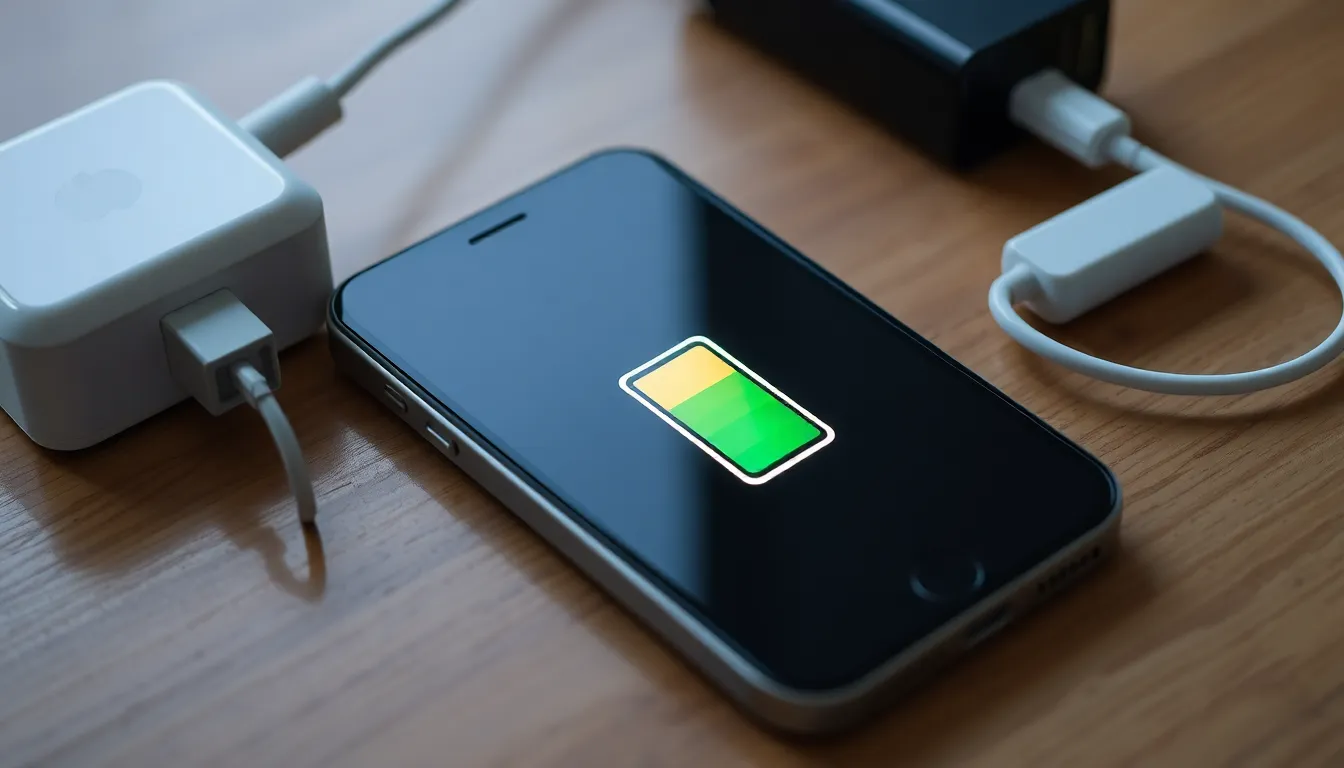When your iPhone’s battery life hits rock bottom, every second counts. Enter Low Power Mode, the superhero of battery-saving features. But here’s the million-dollar question: does it really charge your phone faster? It’s like asking if a turtle can outrun a rabbit—surprising answers might be lurking in the details.
Table of Contents
ToggleOverview of iPhone Charging
Proper charging techniques impact the efficiency of iPhones. Understanding how different modes affect charging speeds can help maximize battery life and performance.
Standard Charging Practices
Charging an iPhone typically involves using a compatible charger and cable. Most users rely on either wall adapters or USB ports for power. Charging the device from 0% to 80% takes less time than reaching a full charge at 100%. Fast charging capabilities come from specific adapters, allowing users to reach up to 50% charge in around 30 minutes. Regular use of high-quality cables further ensures optimal charging performance, reducing overall charging time.
Low Power Mode Explained
Low Power Mode reduces background activity to conserve battery life. This feature lowers the screen brightness and disables fetch for mail, among other functions. Activating Low Power Mode may allow for more efficient power usage during charging. As background processes slow down, the iPhone directs more energy toward charging. Users can enable this mode through the Settings app or quickly via the battery icon in the control center. By focusing on essential functions, Low Power Mode offers a potentially advantageous approach to managing energy.
The Mechanics of Low Power Mode

Low Power Mode optimizes iPhone performance by minimizing energy consumption during charging. This feature plays a critical role in enhancing battery longevity.
Features of Low Power Mode
Low Power Mode disables non-essential functions such as mail fetch, background app refresh, and visual effects. It reduces screen brightness, ensuring that the display consumes less power. It also limits automatic downloads, allowing the device to reserve energy for charging. Users can manually turn on this feature via the Settings app or control center, making it practical and straightforward. Notably, the battery icon changes to yellow, signaling activation of this energy-saving mode.
Impact on Background Processes
Reducing background processes is one of the key aspects of Low Power Mode. This adjustment prioritizes charging efficiency by focusing resources on the battery instead of background activities. Applications like email or social media won’t automatically refresh, conserving battery life during critical periods. Fewer background tasks lead to less power drain, allowing the device to accept charge more effectively. Overall, this focus aids in speeding up the charging process, especially when the battery level is low.
Comparative Charging Speeds
Charging speed between Low Power Mode and Normal Mode offers interesting insights. Low Power Mode significantly reduces background activities, which can enhance charging efficiency. In contrast, Normal Mode allows numerous processes to run simultaneously, potentially slowing down charging.
Low Power Mode vs. Normal Mode
Low Power Mode prioritizes charging by limiting non-essential functions. While in this mode, background tasks like mail fetch and app refreshes are disabled. Normal Mode continues running these tasks, leading to higher energy consumption. Consequently, users often notice that their device charges slower in Normal Mode due to competing background activities. Observing the charging process, devices on Low Power Mode can demonstrate noticeable speed benefits, especially during initial charging phases.
Factors Affecting Charging Time
Charging time depends on several crucial factors. First, the quality of the charging adapter and cable plays a significant role. Higher wattage adapters typically deliver more power efficiently. Second, battery health impacts how quickly a device accepts charge; healthier batteries charge more rapidly. Ambient temperature also affects charging speed, with cooler temperatures often enhancing efficiency. Additionally, the device’s current charge level influences speed; charging from 0% to 80% occurs faster than reaching 100%. All these factors collectively determine the overall charging performance of an iPhone.
User Experiences and Testimonials
User experiences showcase various insights into the effectiveness of Low Power Mode on iPhones. Many users report noticeable improvements in charging speed when utilizing this mode during low battery scenarios.
Real-World Testing Results
Testing conducted by iPhone enthusiasts revealed that charging from 0% to 50% in Low Power Mode often takes significantly less time than in Normal Mode. Specific instances showed a reduction of up to 30% in charging duration within the initial phase. Users also documented faster acceptance of charge in this mode, correlating directly with limited background activity.
Community Feedback
Community feedback emphasizes the preference for Low Power Mode during urgent charging situations. A substantial portion of users notes enhanced efficiency, especially when multitasking is minimized. Additional comments highlight satisfaction with maintaining energy levels while still allowing for basic functions. Many appreciate the convenience of activating this feature quickly, leading to a consensus on its utility for extending battery life during critical moments.
Low Power Mode on the iPhone proves to be a valuable tool for users seeking to maximize charging efficiency. By minimizing background activities and focusing resources on the battery, it significantly enhances charging speeds, particularly during the initial phases. Users consistently report faster charging times when activating this mode, making it an ideal choice in urgent situations.
With the combination of optimized settings and high-quality charging accessories, the advantages of Low Power Mode become even more pronounced. For those looking to extend battery life and improve charging performance, embracing this feature can lead to a more efficient and effective user experience.





